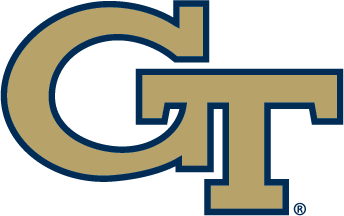July 2, 2003
ATLANTA – Head coach Paul Hewitt fields his most experienced Georgia Tech team since his first season on the Flats, when current seniors Marvin Lewis and Robert Brooks were key freshmen on a senior-laden squad that went to the NCAA West Regional.
Though the Jackets have just two scholarship seniors, the 2003-04 team collectively has 22 seasons of on-court experience, compared to 20 seasons for the group with which they began their careers.
It is that factor, along with a determined off-season effort in the weight room and a deep, talented backcourt, that give Hewitt confidence that Tech can return to the NCAA Tournament.
Even as Tech forged the best Atlantic Coast Conference finish (alone in fifth) of Hewitt’s tenure and won two post-season games, when the Yellow Jackets ended their NIT run at Texas Tech in March, the fourth-year head coach challenged his players to be stronger physically and mentally in the year ahead.
“Strength is the major priority,” said Hewitt, who signed a new five-year contract with Tech on June 30 that extends through the 2007-08 season. “There were times last season that I thought we didn’t have the strength and the stamina to pull things through. Lack of strength will start to tell on you at the end of games with bad turnovers, missed free throws, or missing shots you can normally make. That said, I didn’t feel like we weren’t in shape. Our bodies were just young. We were a young basketball team.
“This year, a year older, a year wiser and a year stronger, we should close games more efficiently.”
All told, the Yellow Jackets return 11 letterwinners, four players who started at least 16 games, and two others who started at least three.
The biggest positive element and the bedrock of this year’s team can be found in the guard and wing positions, where everyone returns from last year’s 16-15 campaign, and two new players join the ranks.
“I don’t think anyone will put out as diverse, as skilled, as physically strong a perimeter group as we will have this year,” said Hewitt. “Physically, they are very strong, mature and experienced.”
The Jackets return the 6-4 senior Lewis (Germantown, Md.) and 6-4 junior B.J. Elder (Madison, Ga.), who rank No. 5 and 12, respectively, among the leading returning scorers in the ACC. Elder, a third-team all-ACC choice who jockeyed with the departed Chris Bosh atop Tech’s scoring chart last season, finished second at an even 15 points a game, while Lewis was third on the squad with a career-best 12.2 per game.
They also both ranked among the league’s top 10 in three-point field goals made and three-point percentage last season. Elder, who ranked seventh in the league in overall field goal percentage (46.1), shot 39.6 percent from behind the three-point line and is fifth in that category among returning players. Lewis is eighth in that group after hitting 36.6 percent of his three-point tries last year.
Lewis, who has diversified his game from the spot-up shooter he was as a freshman, heads into his senior year eighth on Tech’s all-time three-point field goal list with 157, and a career free throw rate of 85.4 percent, which would rank third all-time at Tech if his career were finished. He also begins the season 22 points shy of 1,000 for his career.
Elder, an excellent ballhandler and scorer who can create off the dribble, also is an underrated defender who stymied some of the ACC’s top scorers a year ago.
Lewis and Elder combine with sophomore point guard Jarrett Jack (Fort Washington, Md.) to give the Jackets a formidable starting trio in the backcourt, with 87 starts between them last year.
Jack, who averaged 9.5 points a game and ranked fourth in the ACC in assist average (5.97), held up well as a freshman who was thrown into the fire last season. The 6-3 Jack developed as a scorer as the season wore on, averaging 11.4 points in conference games while hitting 48.4 percent of his shots. But his best talent was setting up his teammates, recording the seventh-best assist total (185) for a season in Tech history, and have gives the Jackets some size and strength defensively at the position.
He will get some help at the point this year from 5-11 junior Will Bynum (Chicago, Ill.), a transfer from Arizona who becomes eligible in mid-December. Bynum, who can play either guard position, gives Jack a capable backup at the point, relieves the burden of running the offense from Elder’s shoulders when Jack rests, and also gives the Jackets another shooter. Bynum, who averaged 6.6 points and 1.4 assists in 39 games (11 starts) with Wildcats, also brings an element of toughness and confidence to the team.
“In many of the close losses last year, if [Jack] had had a little help, maybe things could have swung in our favor,” said Hewitt. “It will mean an awful lot to Jarrett just to have a chance to catch his breath every once in a while in games. He and Will have become very competitive in pick up games, as well as in practice last year.
“It also will help B.J. because there were six or seven minutes in every game last year when he had to play the point guard position. That’s not really his position, though he can handle it, and he did a good job. But now we can keep him on the court, and he can exclusively think about being the two-guard, scoring and creating offense opportunities without having to bring the ball up.”
Tech has strength in numbers on the wings as well, with 6-6 junior Isma’il Muhammad (Atlanta, Ga.) returning at small forward and 6-4 sophomore Jim Nystr?m (Stockholm, Sweden) getting a fresh start at shooting guard after an NCAA suspension and injuries limited him to nine games last year.
Muhammad, Tech’s best on-the-ball defender, started the first six games of the season, but struggled offensively at times. He finished the season on high note by averaging 8.0 points and 5.3 rebounds and shot 52.9 percent in Tech’s three NIT games. Nystr?m, an excellent shooter in his days in Sweden, is expected to give a boost to Tech’s perimeter shooting.
Another player who could figure in the plans for the backcourt is red-shirt freshman Mario West (Douglasville, Ga.), a 6-3 off-guard with similar athletic ability and defensive intensity to Muhammad. West walked on the Tech team last year but earned a scholarship for this season by showing great intensity and dedication in practice, and has worked on his shooting by taking 500 shots daily during the season and since. Both he and Nystr?m will get plenty of opportunity to audition until Bynum becomes eligible in December.
“Jim and Mario both have an opportunity to establish themselves early before Will becomes eligible,” said Hewitt. “There’s no question that Jim’s offensive abilities can help this team. But before Will becomes eligible, with the Pre-Season NIT and other non-conference games, there’s going to be a need to have another guy step up and provide some punch and some energy on offense off the bench. Mario and Jim will be vying for that role.”
Strength is a priority for everyone, but it is imperative for a numerically thin frontcourt unit, where the Yellow Jackets sustained their heaviest losses. Chris Bosh, the Jackets’ 6-10 ACC Rookie of the Year in 2003, was the No. 4 overall pick in the NBA draft, and Ed Nelson, the 6-8 ACC Rookie of the Year in 2002, transferred.
But the returning players in that group, 7-1 junior Luke Schenscher (Hope Forest, South Australia), 6-9 sophomore Theodis Tarver (Monroe, La.) and 6-8 senior Robert Brooks (Saginaw, Mich.), embarked on an intense off-season program in the hopes of mitigating the loss in numbers. They will get help at the power forward spot from 6-7 junior Anthony McHenry, a strong defensive player whose transition from point guard coming out of high school continues now with a move to the frontcourt.
Hewitt has sent two post players, Bosh and Alvin Jones, into the NBA in three seasons, so there is precedent in the Tech’s development of big men.
Schenscher, who gained 40 pounds between his freshman and sophomore years, started 16 games and averaged 3.7 points and 3.1 rebounds for the season. But his contributions diminished as the season wore on, and he shot just 47.2 percent from the floor after connecting on 58.7 percent as a freshman. While all of Tech’s players have spent a lot of time in strength and conditioning programs in the off-season, Schenscher has adopted a more stringent program with a greater emphasis on agility.
“He put a lot of weight on last season, but I’m not sure his body adjusted to the weight gain,” said Hewitt. “He has all the skill, the touch and the knowledge. So I expect him to bounce back this year. He’s working on core strength and working around the basket.”
The most intriguing player on Tech’s roster may be Tarver, an athletic post player with good offensive moves and excellent shot-blocking ability. Tarver spent most of last season adjusting to the intensity and speed of the college game, but came on strong at the end of the regular season. He started all three of Tech’s NIT games (21.7 minutes per game) and averaging 6.7 points, 4.0 rebounds and 1.7 blocks while hitting all eight of his field goal attempts. For the season, Tarver averaged 7.7 rebounds and 4.2 blocked shots per 40 minutes.
“We all recognize that he has some tremendous physical tools,” said Hewitt. “He should be applauded for his patience. He was very patient during the year. There were days when he practiced exceptionally well and probably could have argued for more playing time, but he had faith and trust in our coaching staff and did what we asked him to do. At the end of the year, he got an opportunity and made the most of it.”
The loss of Bosh and Nelson means a new opportunity for Brooks, a high-energy player who appeared in all 61 games his first two seasons (12 starts as a sophomore) but played in just 22 last year and averaged less than a point per game. Brooks, a good athlete and one of the team’s best leapers, averaged 3.4 points and 4.3 rebounds per game as a sophomore, and has made 46.2 percent of his field goal attempts for his career.
Tech’s depth in the backcourt allows Hewitt to give McHenry a different role as a power forward. McHenry has been successful on the defensive end throughout his career and could benefit from a move inside. Statistically, the 6-7 player contributed in a variety of ways last season, averaging 4.8 rebounds, 4.0 assists, 1.6 blocks and 2.8 steals per 40 minutes while posting a 2.06-1 assist-turnover ratio.
“Robert has been in this program for three years,” said Hewitt. “He plays very hard and understands everything we’re doing. He’s been around the league. Given the present state of the frontcourt, he has an opportunity to play more minutes, but it’s going to have to be earned. Tony McHenry has been somewhat frustrated by his opportunities, and he’s going to get a chance. When we looked at Tony this past year, we saw that he played his best basketball when he was in the frontcourt, whether it was small forward or power forward.”
The Jackets’ strong finish last year, with wins over Big Ten members Ohio State and Iowa (on the road) in the NIT, should provide some momentum for 2003-04.
“We finished strong and had some quality wins down the stretch,” said Hewitt. “As a coach, you look for improvement, and I thought we did a nice job of improving. [Iowa] was a great win for our guys, and a nice confidence boost. We can take that into next season as a positive moment to point to.”
“I really think these guys have a great work ethic. I know they’re all working very hard this summer. We have to address some personnel losses. In terms of who we have coming back, those guys grew a lot and learned a lot. Guys like Marvin Lewis, Jarrett Jack and Isma’il Muhammad played their best basketball down the stretch. We know what B.J. can do and how good he can be. He just needs to stay healthy. The guy who will give us a real boost is Will Bynum. He will give us a tremendous lift when he becomes eligible.”
Despite the unexpected losses of Bosh and Nelson, Hewitt remains optimistic because the losses did not severely damage the Yellow Jackets’ depth, and the returning cast includes plenty of experience.
“That’s why we have worked very hard to develop depth and use scholarships so we don’t get caught short,” said Hewitt. “We place a very strong emphasis here on individual instruction, and that enables us to have people step in when others leave.
“I’m very happy where we are, all things considered. We have an extremely strong backcourt, and the makings of a good frontcourt. As people leave, players have an opportunity to step up.”
Tech will test itself early with an appearance in the Pre-Season NIT against Louisiana-Lafayette. A win over the Ragin’ Cajuns could propel the Jackets into subsequent games against Connecticut, Utah, Minnesota, Massachusetts or Texas Tech. Also on the early schedule a Dec. 3 rematch with Ohio State in the ACC/Big Ten Challenge. Once Bynum becomes eligible following fall semester exams, Tech has Saint Louis, St. John’s and Georgia among its foes before opening the ACC slate at North Carolina.









